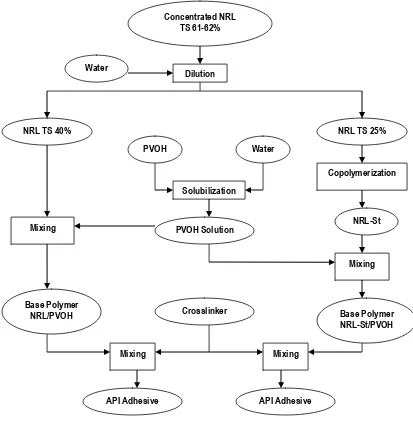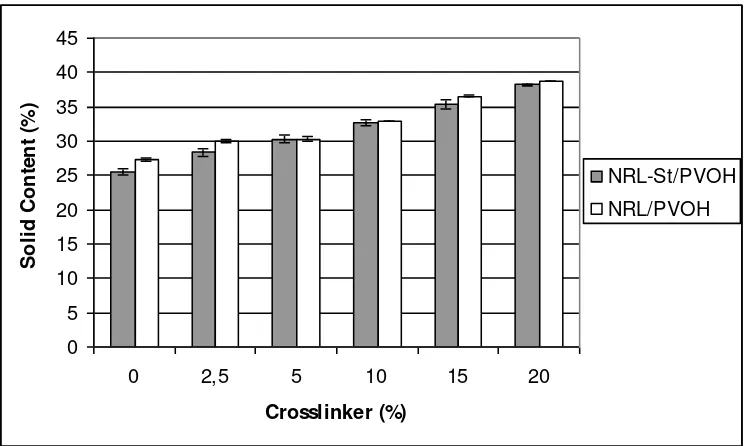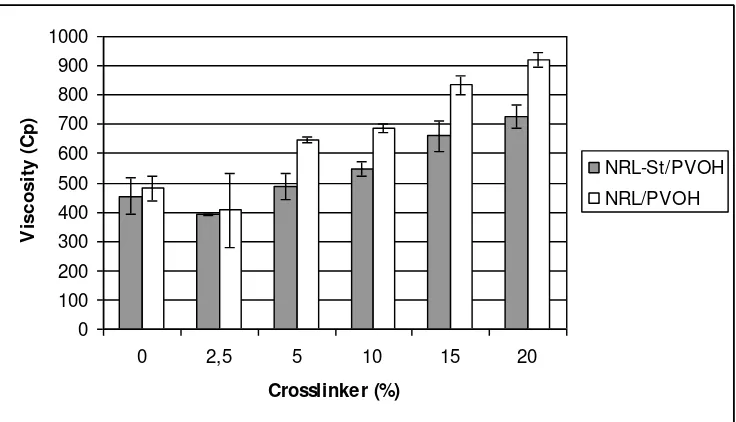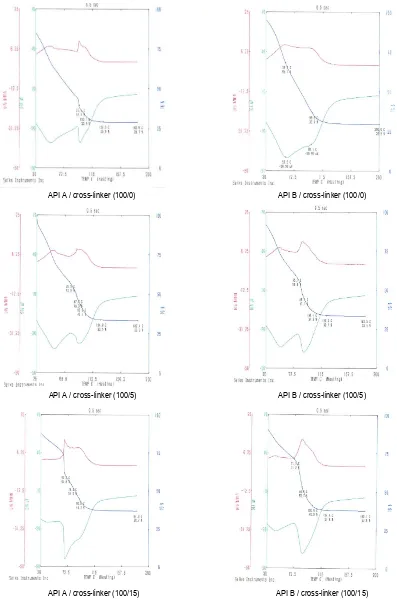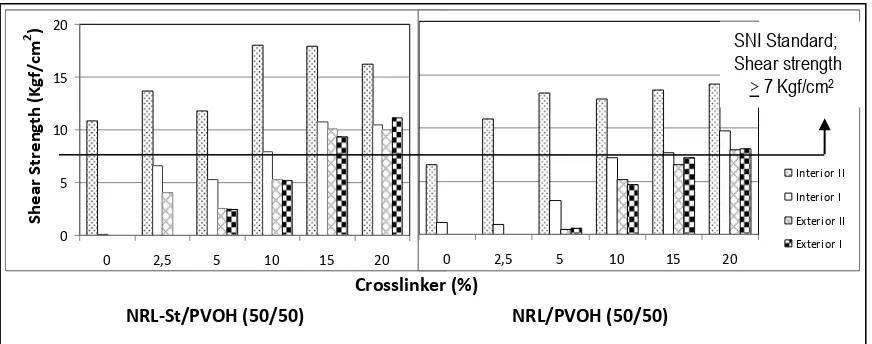Synthesis of Aqueous Polymer Isocyanate for Plywood Adhesive
Euis Hermiati, Dede Heri Yuli Yanto and Faizatul Falah
Abstract
The aim of this research was to produce natural rubber-based Aqueous Polymer Isocyanate (API) adhesives that could meet standard for exterior grade plywood adhesive. Base polymers used were Natural Rubber Latex (NRL), Natural Rubber Latex - Styrene (NRL-St), and polyvinyl alcohol (PVOH).There were two kinds of adhesives produced; one was using NRL and PVOH as base polymers, and the other one was using NRL-St and PVOH as base polymers. Isocyanate crosslinking agent was added to each kind of adhesives at 2.5; 5; 10; 15 and 20% of the weight of the base polymers. They were measured for their total solid content (gravimetric method), pH (using pH meter), specific gravity (using picnometer) and viscosity (using Brookfield viscometer). Thermal analyses using TG/DTA was conducted at the addition of 0, 5 and 15% cross-linking agent. The adhesives were spread on the surface of Red Meranti (Shorea sp.) veneers (250 x 250 x 2.1 mm core; 250 x 250 x 1.5 mm face and back) at the glue spread rate 400 g/m2 DGL (double
glue line). The veneers with adhesives were cold pressed at 10 kg/cm2 for 10 minutes and then hot pressed at 10 kg/cm2,
110ºC for 5 minutes. The plywood produced was conditioned for 2 weeks, then they were measured for their bond strength, delamintaion ratio, water absorption, and thickness swelling. Results of this study showed that either NRL or NRL-St could be used as one of base polymers in preparing API adhesive. Bond strength of plywood adhered with API adhesives made of NRL-St at all levels of isocyanate crosslinking agent addition were higher than those made from NRL. The addition of 10% or more isocyanate croslinkers to NRL/PVOH (50:50) or to NRL-St/PVOH (50:50) could produce plywood having bond strength that could meet interior grade standard. Plywood having bond strength of exterior grade standard were produced when 15% or more isocyanate crosslinkers were added to NRL-St/PVOH (50:50) or when 20% or more isocyanate crosslinkers were added NRL/PVOH (50:50).
Key words: adhesive, aqueous polymer isocyanate, natural rubber latex, plywood, polyvinyl alcohol, synthesis
Introduction
There are mainly two classes of wood adhesives that are usually used in wood or wood working industries, thermosetting and cold setting. In Indonesia thermosetting adhesive mostly used are urea formaldehyde (UF), phenol formaldehyde (PF) and melamine formaldehyde (MF), while cold setting adhesive mostly used are phenol resorcinol formaldehyde (PRF) and epoxy. The three thermosetting adhesives mentioned above raised some problems due to formaldehyde emission, while the cold setting adhesives are usually very expensive and totally imported.
Aqueous or Water-based Polymer Isocyanate (API) adhesive is one type of wood adhesives that is potential to be developed since this adhesive is free of fromaldehyde and can be applied using hot or cold pressing processes. It can also be cured by high-frequency heating. In Japan API adhesive is also known as Aqueous Vinyl Polymer Solution - Isocyanate Adhesives (JAI) or Water-based polymer-Isocyanate Adhesives (JIS). Commercial name of this adhesive in Japan is Suisei Vinyl Urethane Adhesive. In USA and Canada this adhesive is known as EPI (Emulsion Polymer Isocyanate) (Taki et al. 1994)
API adhesive mainly consists of water soluble polymer and emulsion, which are polyvinyl alcohol (PVOH) and polystryrene-co-butadiene rubber Latex (SBR), etc., with isocyanate compounds (polymeric MDI
urea formaldehyde or three times the price of phenol formaldehyde, which are the two most common adhesives used in wood panels Industry in Indonesia.
Natural Rubber Latex (NRL) as well as Natural Rubber Latex - Styrene (NRL-St) are polymers that can be used as adhesives, including wood adhesive. NRL-St adhesive consists of mixtures of natural rubber, free polystyrene and natural rubber grafted with polystyrene. According to our previous research, NRL could be used only for interior grade plywood adhesive with bond strength only 1.5 kgf/cm2 in interior II grade testing
(Hermiati and Prasetya 1998), while NRL-St can be used as exterior grade plywood adhesive with bond strength used as base polymers in preparing API adhesives, since the polymers can be blended well with other water soluble polymers, such as polyvinyl alcohol. By using these polymers as base polymers of API adhesive hopefully could produce the API adhesives that have good bond strength quality, at least the same as that of commercial ones, but with lower price. According to our previous research, bond strength of laminated wood bonded with a commercail API adhesive was 9 ~ 14 Mpa, bond strength of plywood was 11.85 (Interior II grade testing); 6.32 (Interior I grade testing); 6.07 (Exterior II grade testing), and 6.45 kgf/cm2 (Exterior I grade testing).
The aim of this research was to produce API adhesives using natural rubber as base polymer, that could meet standard for exterior grade plywood adhesive.
Materials and Methods
Materials
The concentrated natural rubber Latex of 61 ~ 62 % solid content was obtained from the Jalupang plantation of PTPN VIII, Subang, West Java. Styrene monomer used was technical grade, while potassium peroxodisulfate was analytical grade from E. Merck. Polyvinyl alcohol (AM 11) and crosslinking agent (AX-45) were from Koyo Sangyo, polymers prepared. The first one was prepared from NRL and PVOH, and the other one was from NRL-St and PVOH. The concentrated NRL of 61 ~ 62 % solid content
were consisted of NRL and PVOH as base polymers. The concentrated NRL was also diluted with water to about 25% solid content. This Latex would be used for preparing NRL-St adhesive, which was further used for preparing temperature for 1 hour. After that, the initiator (potassium peroxodisulfate) was added. The mixture was then heated at 65ºC for 1 hour with continuous stirring at 550 rpm. PVOH solution was prepared according to the PVOH manufacturer directions. Powder of polyvinyl alcohol was added into warm water to make 15% solution concentration. They were agitated until all the powder is dissolved in the water. This solution was further used for preparing API adhesives. Flow diagram of API adhesive preparations can be seen in Figure 1.
Preparation and Characterization of API Adhesives. There were two kinds of API adhesives prepared, one was using NRL and PVOH (50/50) as base polymers, and the other one was using NRL-St and PVOH (50/50) as base polymers. Crosslinking agent (AX-45) was added at the level of 0, 2.5, 5, 10, 15 and 20% of the weight of base polymers. Each adhesive was measured for its total solid content (gravimetric method), pH (using pH meter), specific gravity (using picnometer) and viscosity (using Brookfield viscometer). TG/DTA (Thermo Gravimetry/ Differential Thermal Analyzer) analyses were conducted on both kinds of API adhesive at the addition of crosslinking agent of 0, 5 and 15%. Around 10 mg of samples was put in TG/DTA aluminum pan for the analyses. The temperature was programmed from 30 to 200ºC and was raised 10ºC/minutes. Nitrogen was used as purge gas.
Preparation and Bond Quality Measurement of Plywood. The adhesives were spread on the surface of Red Meranti (Shorea sp.) veneers (250 x 250 x 2.1 mm core; 250 x 250 x 1.5 mm face and back) at the glue spread rate 400 g/m2 DGL (double glue line). The veneers
with adhesives were cold pressed at 10 kg/cm2 for 10
minutes and then hot pressed at 10 kg/cm2, 110ºC for 5
Machine, respectively. There are 4 grades of plywood according to the standard, Exterior I, Exterior II, Interior I and Interior II. Standard testing for Exterior I grade involves boiling plywood specimens for 3 hours, drying in an oven at 60ºC for 20 hours, boiling for 3 hours and dipping in water for 20 hours, while that for Exterior II grade is the same except dipping in water only until the specimens reach ambient temperature. Standard testing procedure for Interior grade involves dipping plywood specimens in water at 60ºC for four hours, while that for
Interior II grade is without any treatment. Bond strength value to pass the standard of each grade is 7 kgf/cm2.
Water absorption, thickness swelling and delamination ratios of plywood were measured according to Japanese Agricultural Standard (JAS) for Plywood (2003). Delamination ratios of plywood were determined after soaking the specimens in water at 70ºC (type I) and in boiling water (type II).
Figure 1. Flow diagram of API adhesive preparation. Concentrated NRL
TS 61-62%
Water
Dilution
NRL TS 25% NRL TS 40%
PVOH Water
Solubilization
PVOH Solution Mixing
Mixing Copolymerization
NRL-St
Crosslinker Base Polymer NRL-St/PVOH Base Polymer
NRL/PVOH
Mixing Mixing
Results and Discussion
Properties of Adhesives
Properties of API adhesives can be seen in Figure 2, 3 and 4. Figure 2 shows that total solid content of API adhesives increased due to the increasing of cross-linking agent in the adhesives. As a matter of fact, solid content of the cross-linking agent was very high, around 99%, since a high solid content could be reached by an addition of extenders or fillers. Solid content affected technical aspects of adhesive applications more than bond strength. In this study differences in solid content was mostly due to differences in cross-linking agent level in the adhesives. After obtaining optimum cross-linking agent level in producing products that could meet a standard, solid content could be adjusted by addition of extenders or fillers, so that the adhesives would also be
good in technical application. On the contrary with API adhesives solid content, pH of adhesives decreased by increasing of cross-linking agent in the adhesives (Figure 3). This was because pH of the cross-linking agent (±7) isocyanate cross-linking agent also increased viscosity of the adhesives (Figure 4), even though viscosity of cross-linking agent was much lower than that of each base polymer or blends of the base polymers (50/50). This was probably due to linking formed between the cross-linking agent and the polymers. The effect of addition of cross-linking agent on total solid content of NRL-St/PVOH was almost the same as that of NRL/PVOH. However, its effect on pH and viscosity of NRL/PVOH was higher than that of NRL-St/PVOH.
0 2 4 6 8 10 12
0 2,5 5 10 15 20
Crosslinker (%)
pH NRL-St/PVOH
NRL/PVOH
Figure 3. pH of API adhesives at different level of cross-linking agent.
0 100 200 300 400 500 600 700 800 900 1000
0 2,5 5 10 15 20
Crosslinker (%)
V
is
c
os
it
y
(
C
p)
NRL-St/PVOH
NRL/PVOH
Figure 4. Viscosity of API adhesives at different level of cross-linking agent.
There are three curves shown in TG/DTA grams, the blue ones, thermo-gravimetric curves; the green ones, differential thermal curves; and the red ones, differential thermo-gravimetric curves. TG/DTA analyses of API adhesives (Figure 5a) show that addition of isocyanate cross-linking agent as much as 5% did not give significant effects on the formation of cross-link in the adhesives. This was shown by two peaks formed at DTA (green) curves as those in adhesives without cross-linking agent. This was probably because the reactive groups of the
Figure 5a. TG/DTA analyses of API adhesives (API A : NRL-St/PVOH; API B : NRL/PVOH) at different level of cross-API A / cross-linker (100/0)
API A / cross-linker (100/5)
API A / cross-linker (100/15)
API B / cross-linker (100/0)
API B / cross-linker (100/5)
Figure 5b. TG/DTA analyses of a commercial API adhesive with 15% cross-linker.
Quality of Red Meranti Plywood
Table 1 shows the results of some quality testing of plywood. Water content of plywood samples produced was less than 14%, so that it could meet standard quality of plywood, either according to JAS or SNI. Water absorption of plywood samples was 32.37 ~ 40.30%, and it seems that there was no certain pattern due to differences in base polymers or cross-linking agent levels of the adhesives used. Thickness swelling of plywood
samples was 2.66 ~ 5.70%, and it also seems that there was no certain pattern due to differences in base polymers or cross-linking agent levels of the adhesives used. Results of delamination test (type I and II) of plywood samples showed that all the samples could meet standard of JAS for general purpose plywood, except those that produced using NR/PVOH base polymers with 5% cross-linking agent.
Results of bond strength measurement (Figure 6) show that API adhesives with NRL-St and PVOH as base polymers produced plywood that had higher bond strength than did API adhesives with NRL and PVOH as base polymers. This was because there were more OH groups in the NRL-St than those in NRL, so that there was higher possibility for the former polymer to make cross-link with isocyanate cross-linking agent. All API adhesives produced plywood that could meet standard for Interior II grade, except NRL/PVOH without any isocyanate cross-linker. Plywood of Interior I grade produced when isocyanate was added at the level of 10, 15 or 20%. For exterior purposes, cross-linking agent of API adhesives should be added at the level of 15 or 20%. This was in accordance with the result of TG/DTA analyses of API adhesives produced, which showed that cross-linking of the adhesives was occurred significantly only after the addition of cross-linker reached 15%. Therefore, the optimum level of cross-linking agent for API adhesives made of NRL-St/PVOH or NRL/PVOH was 15%. At that level, the adhesives could produce plywood that could meet the Indonesian National Standard (SNI) for interior and exterior grade plywood.
Table 1. Quality of Red Meranti plywood produced using API adhesives.
Figure 6. Bond strength of plywood adhered with API adhesives at different level of cross-linking agent.
Conclusions
Either Natural Rubber Latex (NRL) or Natural Rubber Latex-Styrene (NRL-St) could be used as one of base polymers in preparing API adhesives. Bond strength of plywood bonded with API adhesives made of NRL-St at all levels of isocyanate crosslinking agent addition were higher than those made from NRL. The addition of 10% or more isocyanate croslinkers to NRL/PVOH (50:50) or to NRL-St/PVOH (50:50) could produce plywood having bond strength that could meet interior grade standard. Plywood having bond strength of exterior grade standard were produced when 15% or more isocyanate crosslinkers were added to NRL-St/PVOH (50:50) or when 20% or more isocyanate crosslinkers were added NRL/PVOH (50:50).
Acknowledgement
We gratefully recognize the International Foundation for Science (IFS) and the Organization for the Prohibition of Chemical Weapons (OPCW), which made a partnership program for funding this research under IFS Grant Agreement No. AF/3268-1. We also wish to acknowledge the Head of R & D Unit for Biomaterials for his support in conducting the project as well as to some researchers at the Laboratory of Polymer, Research Center for Physics for some technical support and valuable discussions for the project.
References
Hermiati, E. and B. Prasetya. 1998. Preliminary Study on Preparing Plywood Adhesive Made of Natural Rubber, Tapioca Starch and Styrene Monomer. Prosiding Seminar Nasional Material dan Lingkungan dalam Pembangunan Industri p. 25-1 - 25-10 (in
Hermiati, E.; M. Utama; B. Prasetya; Sudijono. 2000a. Copolymerization of Natural Rubber Latex with Styrene Monomer and Its Application as Plywood Adhesive. Prosiding Seminar Nasional Teknologi Proses Kimia II, p. E.3-1 - E.3-6 (in Indonesian). Hermiati, E.; B. Prasetya; Sudijono; Nurhayati. 2000b.
Upgrading of Natural Rubber Latex - Styrene Copolymer as Plywood Adhesive. Proceedings of the 3rd International Wood Science Symposium, p. 120 -
125.
Hermiati, E.; W. Fatriasari; F. Falah. 2006. Effects of Synthesis Conditions on Bond Strength of Plywood Adhered with Natural Rubber Latex - Styrene Adhesive. Jurnal Ilmu dan Teknologi Kayu Tropis 4 (1): 33-38.
Hongjiu, H.; L. Hong; Z. Junjin; L. Jie. 2006. Investigation of Adhesive Performance of Aqueous Polymer Latex Modified by Polymeric Methylene Di-isocyanate. Journal of Adhesian 82 (1): 93-114.
Japanese Agricultural Standard (JAS) for Plywood. 2003. Japan Plywood Inspection Corporation.
Standar Nasional Indonesia (SNI) 01-2704. 1992. Mutu Kayu Lapis Penggunaan Umum. Dewan Standarisasi Nasional (DSN).
Taki, K.; H. Yoshida; Y. Yamagishi; T. Inoue. 1994. Mechanical Properties and Bond Strength of Water-based Polymer-isocyanate Adhesives. Proceedings of the Adhesives and Bonded Wood Symposium (Proceedings No. 4735 / FPS), pp. 307 - 316. Taki, K. 1998. Recent Development of Water-based
Received : 05 May 2007 Accepted : 17 May 2008 Final revision : 05 May 2009
Euis Hermiati, Dede Heri Yuli Yanto, Faizatul Falah UPT Balai Penelitian dan Pengembangan Biomaterial - LIPI (Research & Development Unit for Biomaterials - LIPI) Jl. Raya Bogor Km 46, Cibinong, Bogor
